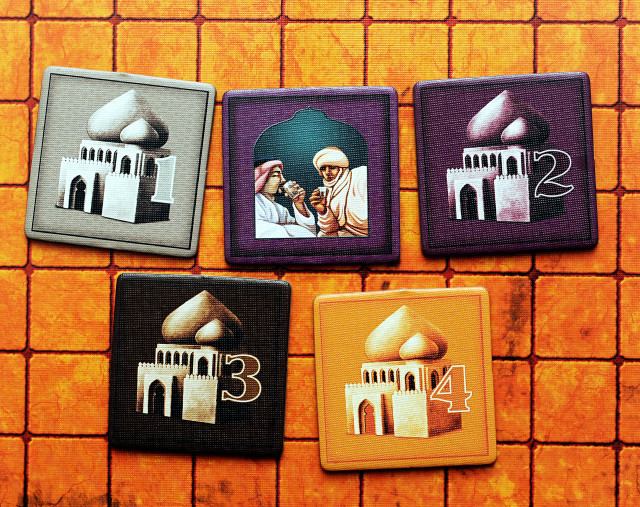Saudi Arabia, 1822. The region of Medina has been left to fall to disrepair. Working together players will rebuild the legendary “Radiant City.” Constructing buildings, walls and markets and claiming them as their own at the most opportune moments.
Medina, designed by Stefan Dorra, was originally published in 2001 and received a well deserved reprint in 2014 by Stronghold Games. The original featured beautiful wooden components of buildings, walls and merchants. I can honestly say that the reprint has done the first version justice. The art in this game is simple but pretty and the bits are nice and chunky wooden constructs.
Medina is a cat and mouse game. Every move you make to improve the conditions on the board improves it for all the players. When to take the leap and claim points for yourself is the crux of the the game.
The Medina board is a grid of small squares. At the start of the game you pick a random spot to place the well and one for a merchant. In a four player game everyone starts with five of each building (Orange, Grey, Brown and Purple), six merchants, nine walls,three stables and four roofs in their colour.
On your turn you’ll take two actions either adding buildings, walls, merchants or stables to the board or you can claim a building by placing your coloured roofs on them.
Each decision is a real balancing act, because you don’t want to claim a building too soon and not max out on potential, but if you wait too long someone else will come along and snag something worth a nice chunk of points. There are advantages to striking early and also to waiting.
Placing buildings requires you to add to an existing or start a new building. There can only be one uncompleted building of each colour at a time, unless it’s impossible to grow that colour any further. Buildings of different colours cannot be touching, even diagonally and all buildings must not be placed within one space of the well. Furthermore a pathway must always exist for the merchants to travel through.
Merchants form a single line of markets. When adding merchants to the board they must extend one end of the line and never branch out in different directions. Stables can be placed in empty spaces next to buildings.
Walls get built in from the four towers at the corners of the city. Each side of the city must have at least one opening in the wall to the outside world. Each tower is worth a certain amount of points from one to four. They will be awarded to the player who most recently connected a building they control to the tower with a wall. Whoever has control of it when the game ends will get the points. This can lead to some intense races with players trying to extend the wall to their property first. 
At the end of the game buildings that you own are going to score points for each building section and for every merchant, wall and stable that is connected to the building. The person with the biggest Orange building will get an extra four points, three for the biggest Brown building, two for Purple and one for Grey.
Once you’ve claimed a building by placing your roof on it you can’t claim another building of that colour for the rest of the game. It narrows your focus to just attempt to grow buildings that you’re still viable to score from or improving your own buildings with stables and merchants. This is the part of the game that players can take advantage of the fact that they’re the only player left growing a Brown building (for example). They’re able to build it bigger and bigger without fear of someone else coming along and claiming it.
Claiming Purple buildings gives you an interesting advantage. There are six Tea Tiles in the game. The first player to claim a Purple building will take three of them, the second will take two and the third will grab the remaining tile. Tea Tiles can be spent to skip your turn. Now it wasn’t immediately evident how this would be helpful at first, but in the late game avoiding making a move can mean extra points for you or avoiding giving points to someone else. It also lets you stay in the game longer.
How does the game end? When there are no more legal moves or everyone has used all four of their roofs the game ends. Points are totaled up for the value of each city, points for the biggest city in each colour and tower points.
It feels very abstract as your playing the game, but with such an interesting mechanic. I love the idea that each move you make improves the board condition for everyone. You’re hoping for a chance to grab something great when it comes around to you, but it’s a commitment to claim a building. You might grab it just to have another be ripe for the taking on your turn.
I really like this game. I think it can appeal to players of all different skill level. Stronghold has done a great job with the reprint. Give it a try if you get the chance.
Comments
No comments yet! Be the first!